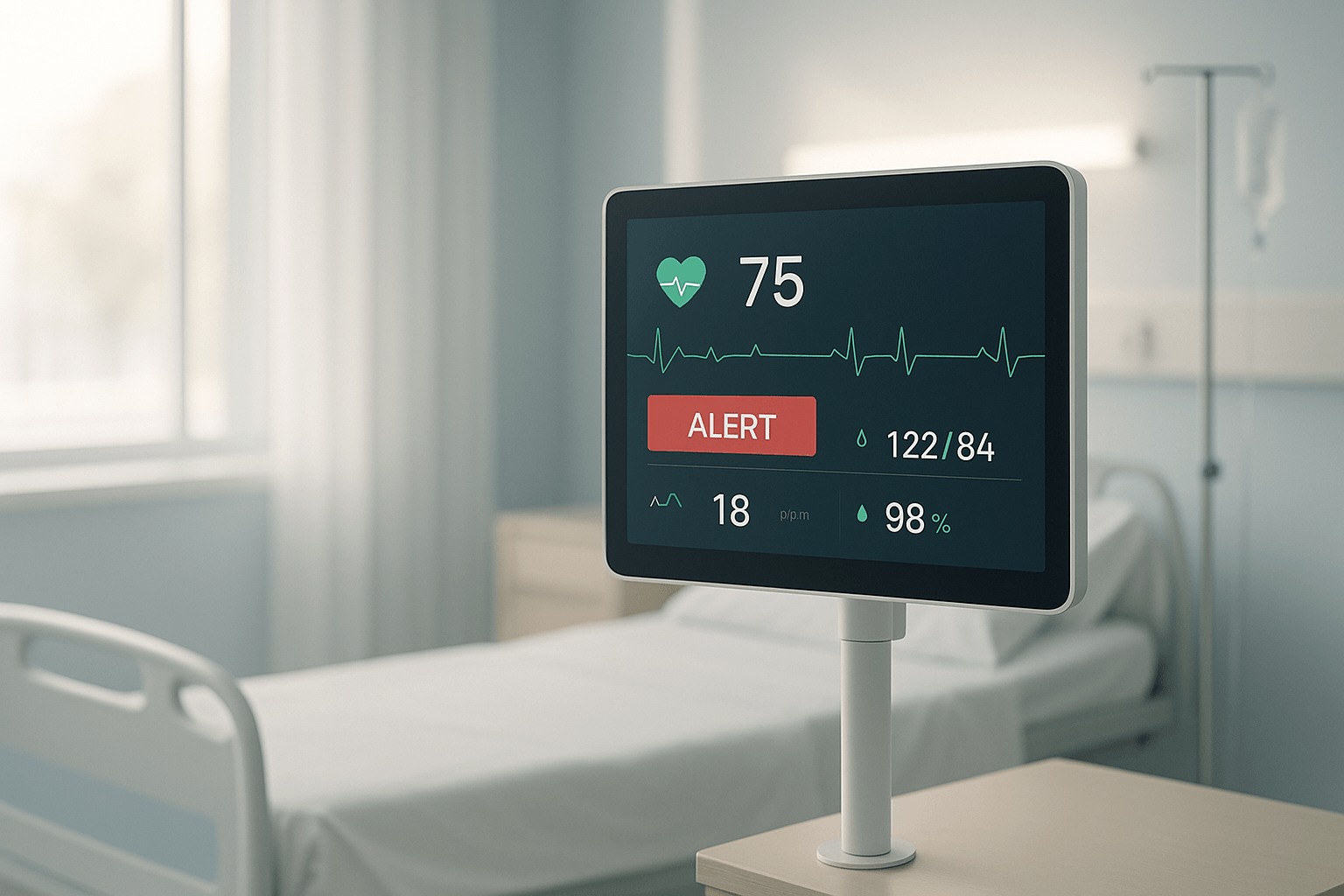
How AI Improves Patient Outcomes with Alerts
AI alert systems spot critical conditions 6 hours earlier than standard methods, cutting hospital stays by 6.2% and saving $944 per patient.

Written by
Adam Stewart
Key Points
- Spot sepsis and critical conditions 6 hours earlier with 83% accuracy
- Save $944 per patient by preventing complications with faster alerts
- Cut care plan abandonment by 41% with personalized monitoring
- Reduce hospital stays by 6.2% using predictive risk assessment
AI health alert systems are transforming patient care by enabling faster responses, better monitoring, and more personalized treatments. Here's what you need to know:
- 24/7 Monitoring: AI tracks vital signs continuously, ensuring no critical change is missed.
- Faster Alerts: Automated notifications reach medical staff within minutes, improving response times.
- Personalized Care: AI adapts to individual patient needs, creating tailored care plans and reducing risks.
- Improved Detection: Conditions like sepsis and strokes are identified earlier than traditional methods.
- Cost Savings: Hospitals reduce complications, shorten stays, and save up to $944 per patient.
Quick Stats:
- AI detects sepsis 6 hours earlier with an 83% success rate.
- Stroke detection accuracy improves to 97%, cutting response times to under 4 minutes.
AI systems are already enhancing emergency care, cardiology, and chronic disease management, proving essential for modern healthcare. The result? Better outcomes, fewer delays, and more efficient operations.
How AI Health Alerts Work
AI health alert systems improve patient monitoring by analyzing data in real-time and automating critical decisions. These systems constantly evaluate patient information using algorithms designed to identify health risks before they escalate.
Key Components of AI Health Alerts
AI health alert systems are built on three main elements:
- Data Collection Interface: Connects to monitoring devices and electronic health records.
- Processing Engine: Uses machine learning to analyze incoming data.
- Alert Distribution System: Sends notifications to the appropriate healthcare providers.
Unlike traditional systems that depend on fixed thresholds, AI-based alerts adapt to each patient's unique condition.
Methods for Patient Data Analysis
These systems enable advanced methods for analyzing patient data, which are essential for proactive care:
- Pattern Recognition: Identifies subtle changes in vital signs and triggers immediate actions.
- Predictive Analytics: Leverages historical data to anticipate potential complications.
- Natural Language Processing: Interprets medical notes and patient communications for deeper insights.
These methods support a range of clinical applications, making patient care more responsive and efficient.
Current Uses in Healthcare
AI is already making an impact in various healthcare settings. Emergency departments use it to detect sepsis early, allowing for faster treatment. In cardiology, AI monitors heart rhythms, while intensive care units track multiple vital signs in real-time. Pharmacies also benefit from AI alerts to flag potential drug interactions.
AI tools also enhance alert management by prioritizing urgent cases and directing information to the right professionals. In critical situations, these systems escalate alerts automatically and activate response protocols.
"I've found Dialzara to be incredibly efficient and authentic", says Bobby James Fournier.
AI continues to refine its ability to understand medical language and context, helping healthcare providers handle growing patient demands. These applications demonstrate how AI can improve operations and communication, paving the way for even more advancements in the future.
Main Advantages of AI Alerts
Recent research highlights how AI health alerts can reduce delays in medical interventions and improve patient outcomes across various healthcare environments.
Faster Medical Response Times
AI alerts significantly shorten the time between identifying patient deterioration and initiating clinical action. At Mount Sinai Hospital, care teams were 43% more likely to escalate treatment quickly when using AI-generated alerts, resulting in improved patient outcomes. These systems analyze multiple data sources to flag potential issues 6–12 hours earlier than traditional monitoring techniques.
"AI's pattern recognition identifies deterioration signatures invisible to human observers, particularly in patients with atypical presentations", says Dr. Matthew Levin, a clinical informatics expert.
This faster response lays the groundwork for AI's ability to enhance diagnostics.
Improved Disease Detection
AI systems consistently outperform traditional methods in identifying diseases, as shown in the table below:
| Condition | AI Detection Rate | Traditional Detection | Time to Detection |
|---|---|---|---|
| Occult Sepsis | 83% | <70% | Within 6 hours |
| Large Vessel Occlusions | 97% | 79% | Under 4 minutes |
At Ascension Texas Cardiovascular, AI tools have enhanced stroke detection by providing instant imaging access and automated analysis.
"AI's role in prioritizing high-risk PE cases before symptoms appear has transformed our emergency response protocols", explains Dr. Peter Monteleone, an interventional cardiologist.
Tailored Patient Care Plans
AI goes beyond quick responses and accurate detection by creating personalized care plans. For example, MyPlan's system reduced care plan abandonment among dementia patients by 41% through tailored reminders and simplified instructions. These systems adjust recommendations based on:
- Optimized medication schedules
- Timing of therapy sessions based on activity
- Real-time treatment changes based on vital signs
- Dietary plans aligned with health markers
For chronic illnesses, AI minimizes medication conflicts by 37% and updates risk scores every 15 minutes to enable immediate treatment adjustments. These tools integrate smoothly with existing healthcare systems, improving standard practices.
"The integration of AI alerts has reduced hospital stays by 6.2% and cut per-patient costs by $944 by preventing complications", according to a Cedars-Sinai study, showcasing both medical and financial benefits of AI-powered care.
Implementation Issues and Solutions
AI health alerts have potential, but healthcare organizations encounter hurdles when putting them into practice. Tackling these challenges is essential for a secure and efficient rollout. Here's how to address some of the main issues.
Patient Data Protection
Healthcare providers must ensure AI alert systems comply with HIPAA while delivering benefits. To achieve this, use end-to-end encryption, role-based access controls, and automated audit trails. These measures help safeguard patient data while meeting regulatory standards.
System Compatibility
To integrate AI alert systems into existing healthcare setups, upload necessary resources like training documents, call scripts, and website links. Adjust configuration settings to align with departmental workflows, making the integration process smoother and more efficient.
Medical Accuracy Testing
Operate AI alerts alongside traditional systems to spot any inconsistencies. Regularly review system performance and update training materials to ensure the alerts remain aligned with clinical guidelines. This helps maintain reliable and high-quality patient care.
sbb-itb-ef0082b
AI Communication Tools in Healthcare
Healthcare facilities are using AI communication tools to improve alert systems and ensure critical patient messages are delivered to the right people. These tools work alongside AI health alerts to streamline patient interactions and guarantee vital notifications are handled properly.
AI Phone Support Advantages
Studies reveal that while 60% of customers call local businesses, only 38% of those calls are answered. AI solutions address this gap by performing key tasks like:
- Capturing accurate messages: Ensuring patient data is recorded correctly.
- Routing urgent alerts: Directing critical health notifications to the appropriate medical staff.
- Managing appointments: Automating scheduling processes without losing precision.
These features make AI tools essential for building advanced phone support systems in healthcare.
Around-the-Clock Alert Handling
Monitoring alerts 24/7 is crucial for patient safety. AI-powered communication systems ensure:
- Critical alerts are always addressed promptly.
- Patient messages and emergencies are processed without delay.
- Medical staff can dedicate more time to direct patient care.
These systems go beyond phone support, offering uninterrupted and efficient alert management.
Easy Setup and Cost Efficiency
Setting up these tools typically involves:
- Creating an account and configuring medical protocols.
- Uploading training materials and call scripts for AI learning.
- Integrating the system with existing phone networks.
- Testing and fine-tuning alert workflows for seamless operation.
Healthcare organizations can reduce communication management costs by up to 90% while improving response times.
"I'm very pleased with your service. Your virtual receptionist has done a remarkable job, and I've even recommended Dialzara to other business owners and colleagues because of my positive experience", says Derek Stroup, a healthcare professional.
These tools can be tailored to include specific medical terms and protocols, ensuring accurate handling of health-related communications. By simplifying communication processes, healthcare providers can cut costs and deliver faster care, improving patient outcomes.
Conclusion: Next Steps for AI Health Alerts
To fully leverage AI in healthcare, providers need solid infrastructures in place. A strong foundation is key to ensuring these systems improve patient care effectively and reliably.
Here’s where to focus:
1. System Assessment and Setup
Start by reviewing your current communication systems. Look at call volumes, peak times, and specific patient needs. Use this analysis to identify areas for improvement and set benchmarks for success.
2. Integration and Training
Key steps include:
- Uploading medical protocols and relevant terminology
- Setting up alert priorities and routing rules
- Training staff on new processes
- Testing the system to handle different scenarios effectively
Once implemented, ongoing monitoring is essential to maintain performance.
3. Monitoring and Optimization
Regularly review system performance to ensure it meets healthcare standards and patient expectations. Track metrics like response times, patient satisfaction, and alert accuracy to make necessary adjustments.
AI health alert systems will continue to advance, offering better tools for patient care. Providers who adopt these technologies now will be better positioned to deliver faster, more effective communication and care. Combining AI's precision with medical expertise can create a more responsive, patient-focused healthcare system. By acting today, providers can set the stage for improved outcomes and efficiency in the future.
FAQs
How do AI health alert systems protect patient data while improving outcomes?
The provided source does not include specific details about how AI health alert systems ensure patient data privacy and security. However, AI systems in healthcare typically prioritize compliance with strict regulations like HIPAA in the U.S., which governs the use and safeguarding of sensitive health information. For more details, consult the system provider or relevant documentation.
What challenges do hospitals face when adopting AI health alert systems into their current infrastructure?
Integrating AI health alert systems into existing healthcare infrastructure can be complex. Hospitals often face challenges such as ensuring compatibility with legacy systems, maintaining strict patient data privacy and security standards, and managing the costs of implementation and training. Additionally, staff may require time and support to adapt to new workflows and trust AI-driven recommendations.
Despite these challenges, the benefits of faster interventions and improved patient outcomes make AI health alert systems a valuable investment for modern healthcare facilities.
How does AI improve the accuracy and speed of health alerts compared to traditional systems?
AI-driven health alerts significantly enhance both accuracy and response time compared to traditional systems. By analyzing vast amounts of patient data in real-time, AI can detect subtle patterns and anomalies that might be missed by conventional methods. This enables healthcare providers to identify potential issues earlier and intervene more quickly.
Additionally, AI systems continuously learn and adapt, improving their predictive capabilities over time. This ensures that alerts are not only more precise but also reduce false alarms, allowing medical professionals to focus on the most critical cases. These advancements contribute to better patient outcomes and more efficient care delivery.
Summarize with AI
Related Posts
How AI Personalizes Patient Education
Explore how AI personalizes patient education, enhancing understanding, engagement, and health outcomes through tailored content and real-time adjustments.
AI Patient Reminders Cut No-Show Rates
Discover how AI-powered reminders are helping healthcare providers reduce patient no-shows. Learn about the benefits, implementation steps, real examples, and ethical considerations.
AI in Healthcare: Improving Patient Communication
Explore how AI enhances patient communication in healthcare by simplifying medical jargon, providing 24/7 support, and personalizing interactions.
How AI Improves Patient Data Analysis
AI is revolutionizing healthcare by enhancing patient data analysis for early disease detection, outcome prediction, and personalized treatment.
